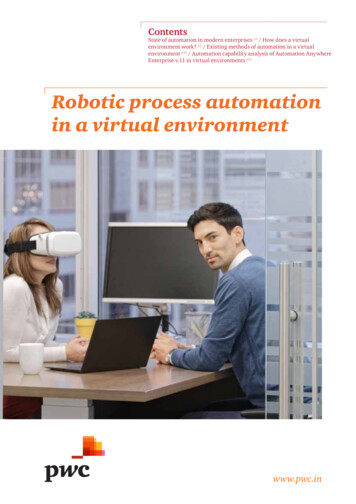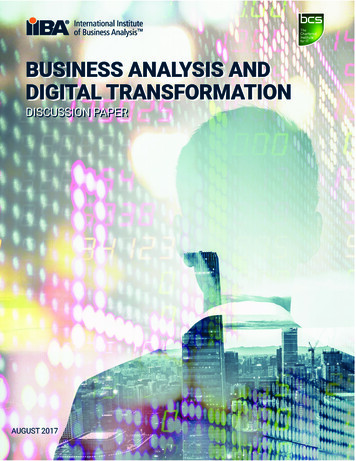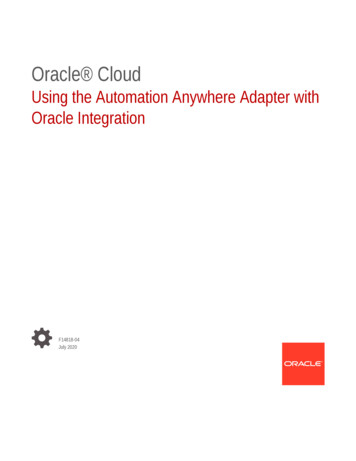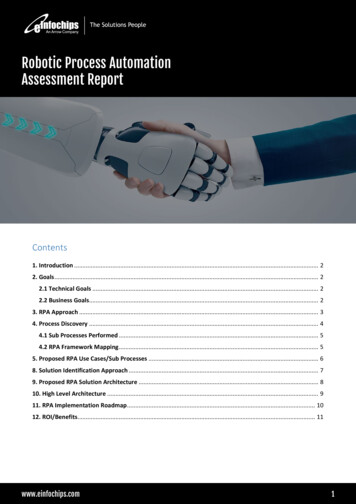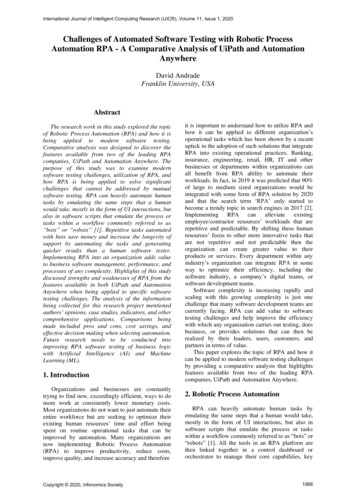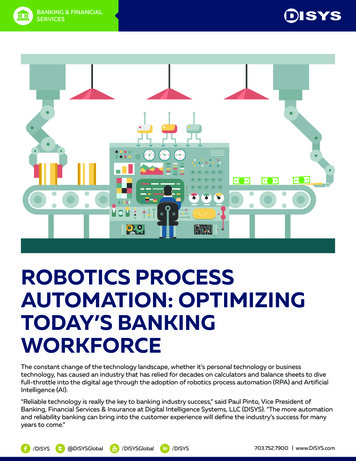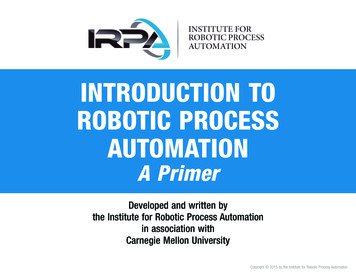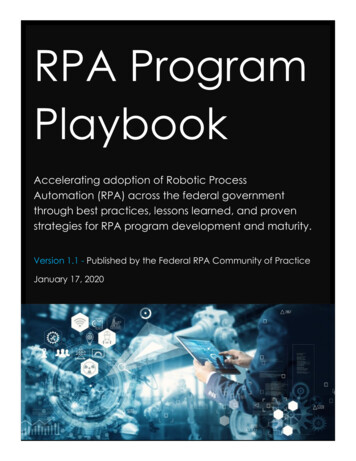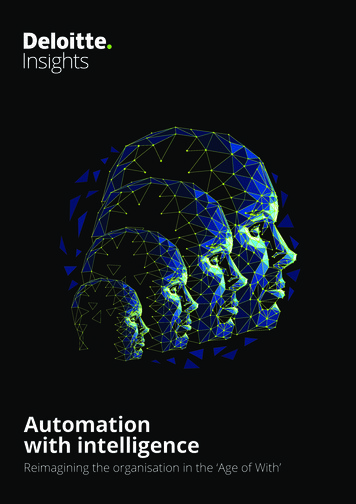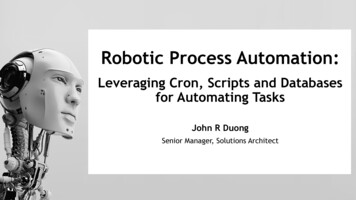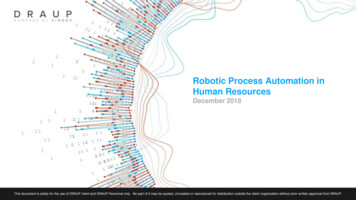
Transcription
Robotic Process Automation inHuman ResourcesDecember 2018
Robotic Process Automation (RPA) involves use of software bots for automation of businessprocessesRPArefers to the use of a preconfigured software instance that uses business rules and predefined activity choreography to complete the autonomousexecution of a combination of processes, activities, transactions, and tasks in one or more unrelated software systems to deliver a result or service withhuman exception management.*Drivers forGrowth inRPAadoptionLower Cost ofOperationsEfficiency GainsQuality &ComplianceRedeployment of peoplefrom mundane processesScalabilityEvolution of Robotic AutomationTraditional Automation(Script based)Robotic Automation(Rule Based)RoboticAutomation(Cognitive)Platform specific/ runs on data layerPlatform agnostic and runs on UIlayerManual exception handlingManual exception handlingPlatform agnostic and runs on UIlayersLearns to handle exceptions overtime; intelligent decision makingenabled by ML algorithmCoding skills requiredCoding skills typically not dUnstructuredSource: DRAUPanalysis*IEEE Standard 2755-2017 definition of RPADataTypeSemi-structuredUnstructuredCoding skills typically not red2
DRAUP analysed 30 HR processes and bucketed them across 6 HR functionsHRStrategyTalent AcquisitionTalent Development &PerformanceManagementHRPolicies Developmentand ManagementJob RequisitionLearning Programmes andContent DevelopmentPayroll & CompensationEmployee DataManagementAdminister SurveysOrganizational DesignManagementRecruitment MarketingAdminister Training andAssessmentBenefits tionsWorkforce ForecastingApplicant SourcingPerformance ManagementRewards and RecognitionTimesheet ManagementEmployee GrievanceManagementCompetency ManagementModel DevelopmentApplicant AssessmentCareer & SuccessionPlanningHRMetrics DevelopmentEmployee OnboardingEmployee OffboardingApplicant InformationManagementEmployee Health andSafety ManagementInternal MobilityManagementReporting andComplianceCompensation &BenefitsHROperationsEmployee RelationsExpense ManagementScheduling and LogisticsNote: DRAUPanalysed 100 HRactivitiesSource: DRAUPanalysis3
DRAUP’s “Use Case Prioritization Framework” – Definition of parametersUse Case Prioritization FrameworkRPA RelevanceRPA AdoptionSub-parametersNet FTE Replaced:Percentage of workforce that can be replaced through RoboticProcess Automation. Rule based nature:Highly rule based (less human judgement) processes with lowcomplexity are rated higher on RA relevance A detailed mapping of use cases being addressed by100 firms including RPA software vendors andenterprises was done through primary and secondaryresearchUse cases were then prioritized based on frequency ofoccurrenceHigh Data Processing Errors:Processes with high rate of errors in data processing andcompliance issues are rated higher on RA relevanceHigh Demand Fluctuation:Processes with high demand fluctuation are rated higher on RArelevanceSource: DRAUPanalysis4
RPA Propensity Heat Map: 17 HR processes were identified with high RPA relevance levelsRPAAdoptionHighEmployee OnboardingLeave/Absence ManagementPayroll andCompensationEmployee DataManagementExpense ManagementReporting & ComplianceAdminister SurveysPerformance ManagementRPARelevanceLowTimesheet ManagementApplicant SourcingEmployeeCommunicationsManageEmployee Health&Job RequisitionApplicantEmployee OffboardingSafety ManagementInformationCareer &Workforce Succession PlanningOrganization DesignRewardsApplicant nManagementRecruitment tingEmployeeGrievanceand LogisticsManagementManagement ModelDevelopmentManagementAdminister TrainingDevelopmentHRPolicies& AssessmentLearning Programs andDevelopment andLowContent DevelopmentManagementHRFunctionSource: DRAUPanalysisHRStrategyandPlanningTalent AcquisitionTalent fitsHROperationsHighEmployeeRelations5
High propensity use case analysis: RPA Bots are good at extracting, augmenting and processingdata;launching and interacting with multiple enterprise software products (1/2)RARelevanceFunctionUse CaseNet FTEreplaceableRule derateApplicant SourcingTalent AcquisitionApplicantAssessmentLowManage nt Development& Source: DRAUPanalysisHighBenefitsManagementRewards& RecognitionBot Automation Areas Bots can automate publishing jobs to company’s website orjob portals, preliminary screening of applicants, schedulingInterviews, notifications on the status of the applicantautonomously. RPA can automate managing applicant information acrossmultiple systems from initial application submission tocompleting the new hireprocess. Bots can assess, prepare and create new joiner data, sendout offer letters, streamline information across disparatecorporate systems for preparation on day 1, & consolidateinputs from business areas and feed to downstreamsystems.HighPayroll andCompensationCompensation &BenefitsEnterpriseAdoptionLowEnterprise Adoption LevelHigh Low Bots can send out performance review forms to employeesand managers, check data, feed data into multiple systems,notify employees of additional requirements, scheduleinterviews, publish predefined employee performancereports available to managers asper schedule Autonomous Update of Master Payroll file, Payroll Inputs,Validate time & attendance data, Gross & Net Salarycalculation, Distribute Pay slips (online), & Deposit & Reportdues such asTDS,PF,ESIetc. Bots can educate employees about available benefitsthrough notifications or email, create analytical reports onbenefits utilization by collating data from multiple systems Send out rewards nomination forms, check submitted data,send out emails for recognition for rule based records, feeddata into payroll systemsfor monetary rewardsLowDecreasing Rating6
High propensity use case analysis : RPA Bots are good at extracting, augmenting and processing data;launching and interacting with multiple enterprise software products (2/2)RA RelevanceFunctionEmployeeRelationsHROperationsUse CaseNet FTEreplaceableRule ployee GrievanceManagementLowAdminister SurveysModerateEmployee loyee DataManagementHighLeave/ AbsenceManagementHighReporting &ComplianceHighExpense ManagementHighScheduling &LogisticsLowEnterprise Adoption LevelSource: DRAUPanalysisEnterpriseAdoptionHigh LowBot Automation Areas Bots can track employee grievance requests, track processstage and send out notifications for early case completionand higher visibility Bots can send out regular surveys, check for data completion,and build reports for management for furtheraction. Bots can send out various exit requirements, notifyauthorities of non-compliance, missing data and send outexit letters upon process completion Automated review of employee time records, leave/absencerecords daily for accuracy & completion. Notify employee or manager of any missing information tofix defects and maximize payroll accuracy. Bots can extract data from multiple files, clean it and enter itinto payroll systems. Data capture and cleansing to support automated generationof reports Pre-populating complex periodic reporting requirements Auto approval of standard expenses based on definesbusiness logic and feed data into expense systems Bots can schedule interviews by checking multiple systemsfor suitable time, send out emails, reschedule as perrequirement and call for manual intervention if requiredDecreasing Rating7
RPA Talent Requirement: Enterprises leverage a mix of technical roles, business roles and domainexpertise to build in-house RPA capabilitiesTalent Requirement for RPACapability BuildingTrends in RPATalent Building1Key Job titles SkillsTechnicalRoles Languages: C/C ,Python, VB Script, Ruby,Java, JS, .NET RPAtools: Blue Prism,Automation Anywhere,UiPath, Work Fusion,OpenSpanRPADeveloperRPASolution ArchitectRPATechnical LeadAutomation EngineerAutomation DeveloperRPASystem ArchitectSource: DRAUPanalysisDomain/Process RolesManagementRolesEmployees are trained on 2-3 tools and training lasts 3-4months Training through RPAtool vendors Training by internal/ inhouse RPAengineers Hands-on training with delivery team2 RPABusinessAnalyst BusinessProcessArchitect Automation ProcessArchitect Process Engineer RPASpecialist Program Manager–(RPA) Automation Manager(RPA) RPAProject Manager Visualization tools:Power BI, Tableau, andSplunk Other tools: iGrafx,Prosci/ADKAR ,Helix ,Lean Six Sigma and RPAtools Strategy planning Team management/Changemanagement PoCimplementationmanagement Business Planning Knowledge of RPAtoolsInternal Training ProgramsRACertifications and Training AcademiesCompanies such as Blue Prism & UiPathhave dedicated training/ accreditationprograms with certifications for RPAtalent3Outsourcing consultantsCompanies usually outsource RPAexperts or consultants from ITcompanies like Cognizant , Accentureand more8
Technical roles: RPA developer and RPA Solution architect are the key technical job roles which augmentinternal IT teams in implementing RPAsolutionsJob Architect / RPATechnical Lead (Solution Architect /System Architect )DescriptionDevelopment,Support, Testing andDeployment of RPAtools in the enterpriseResponsible foroverall design andarchitecture of thesolution and act as aliaison betweendevelopers andproject managerSkillsWorkloads Java or .Net (C#, VB, etc)or Oracle PL/SQL / VBA /HTML, scripting language(JS/ VBS/ JavaScript) RPAtools: AutomationAnywhere, UI Path, Blueprism Responsible for bot development & maintenance as per development and SLAstandards Work collaboratively with stakeholders during the system test and UATphases to fixassigned bugs with quality Responsible for defining & meeting RPAUse Cases milestones, monitoring adherence toproject scope, requirements and design documents Support RPAdelivery by assessing the technical feasibility of a solution & collaboratingwith the technical leads/architects on bot design Proactively address issues and risks (Bot Ids entitlements, Bot VDIs, Bot on-boarding,migration etc.) that could impact project schedule and/orbudget Java / .NET (C#, VB, etc.)/VBA / HTML/ SQL, JS/ VBS/JavaScript RPAtools: AutomationAnywhere, UI Path, Blueprism Provide technical direction for the development, design, and systems integration fromdefinition phase through to implementation Design and architect the product/solution Ensure that the product/solution architecture is scalable and extensible Keep the project manager well informed of the status of development effortsand servesas liaison between development staff and the project manager Own the development lifecycle and should be responsible for managing technical risksthroughout the project Performs code reviews and mentors junior developers Understand complex database concepts and effectively employs different databasedesign techniquesSource: DRAUPanalysisNote: Above mentioned are key Job titles found for ‘Technical roles’ across industry and are not exhaustive, different companies may have other different job titles with similar workloads9
Domain and Management Roles: RPA process architect and Business analyst collaboratewith HR processSMEs to define HR process workflowJobTitlesRPAProjectManager ( RPAProgramManager/RPAManager)RPABusinessAnalyst (RPAAnalyst)RPAProcessArchitect( AutomationProcess Architect,Business SkillsDescription/WorkloadsLead the transformation effortto RPAtechnology and solvebusiness and technicalproblems Lean Six Sigma, Agile,Project management RPAtools: AutomationAnywhere, UI Path,Blue prism Lead the transformation effort to standardize the delivery management and enabling technology landscapetoachieve cost efficiency and service delivery performance Responsiblefor engaging various stakeholders to identify opportunities to leverage best robotic processautomation practices to optimizedelivery Analyzing existing systems and providing technical solutions Translate businessrequirement document to software requirement specifications Recommendand build scalable processesand infrastructure for enterprises Concept presentations to businessstakeholders and ensure all queries are addressedRPABusiness Analyst willgather and document businessrequirements, configurationdesigns, test plans and results,and other deliverables requiredto implement RPAsolutions Tableau, Qlik, MSExcel, SQL RPAtools: AutomationAnywhere, UI Path,Blue prism Work closely with businessexperts to document and define businesscasesand best uses for RPA Participate in RPAproposal creation andevaluations Responsiblefor providing peer review of ad hoc reporting, change management, implementation ofscheduled changes, and documentation ofStandard Operating Procedures Designing interactive visual interfacesand dashboards Integrate and synthesize information from multiple sources in order to analyze complex data and results,anticipate issues and solve problemsDesign, and optimize businessprocesses, determine targetprocesses ideal for automation,work on ‘how’ to buildsolutions using RPA Product managementtools - Aha!, JIRA,business casedevelopment fromscratch RPAtools: AutomationAnywhere, UI Path,Blue prism Work with stakeholders (Process SMEs, Technical Architects & Operations Team) toanalyze and assessautomation feasibility Analyze and observe processes to understand process steps, inter dependencies and applications used inprocesses Translate business requirements, current and future state process designsto create automation readyprocess flows Work with the RPA Solution Architect to create a final TO-BE state Robotics solutionDefine HRprocesses workflow HRprocessexpertise Works with RPAprocess architect and Business analyst to document business requirementsNote: Post implementation of RPA, management and resource allocation of RPA bots is required, this task is typically performed by HR personnel with knowledge of the automated processSource: DRAUPanalysisNote: Above mentioned are key Job titles found for ‘Technical roles’ across industry and are not exhaustive, different companies may have other different job titles with similar workloads10
Draup is an enterprise decision-makingplatform for global CXO leaders in salesand talent domains.Love our reports? Subscribe to ourregular newsletters to receive industryinsights right into your mailbox!Want to know how Draup can help yourSales and Recruitment Teams? Get intouch with us at info@draup.com
( Automation Process Architect, Business Process Architect) Design, and optimize business processes, determine target processes ideal for automation, work on ‘how’ to build solutions usingRPA Productmanagement tools - Aha!, JIRA, business case development from scratch RPA tools:
